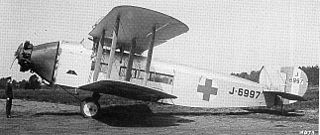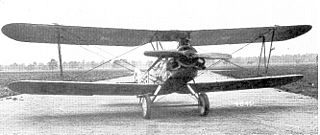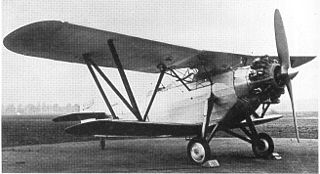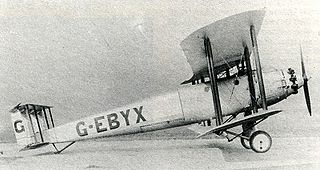
The Boxkite was the first aircraft produced by the British and Colonial Aeroplane Company. A pusher biplane based on the successful Farman III, it was one of the first aircraft types to be built in quantity. As the type was used by Bristol for instruction purposes at their flying schools at Larkhill and Brooklands many early British aviators learned to fly in a Boxkite. Four were purchased in 1911 by the War Office and examples were sold to Russia and Australia. It continued to be used for training purposes until after the outbreak of the First World War.

The Short Springbok was a two-seat, all-metal reconnaissance biplane produced for the British Air Ministry in the 1920s. All together six aircraft of the Springbok design were built but none entered service with the armed forces.

The Short L.17 Scylla was a British four-engined 39-seat biplane airliner designed and built by Short Brothers at the request of Imperial Airways to supplement the Handley Page H.P.42 fleet already in service after Handley Page quoted an excessive price for two additional H.P.42s. They were ordered in 1933.

The Armstrong Whitworth A.W.14 Starling was a prototype British single-seat biplane fighter developed for the Royal Air Force in the late 1920s which unsuccessfully competed against the Bristol Bulldog.

The Bristol Ten-seater and Bristol Brandon were British single-engine biplane transport aircraft built by the Bristol Aeroplane Company in the early 1920s. Only three were built, two of which were used as civil transports and one of which served with the Royal Air Force.

The Bristol Taxiplane and Bristol Primary Trainer were British single-engine biplane light aircraft built by the Bristol Aeroplane Company in the early 1920s. A total of 28 were built, being mainly used as trainers.

The Bristol Gordon England biplanes were a series of early British military biplane aircraft designed by Eric Gordon England for the Bristol Aeroplane Company that first flew in 1912. Designed for easy ground transport, the aircraft could be quickly disassembled.

The Bristol Bloodhound was a British two-seat reconnaissance/fighter aircraft designed and built by the Bristol Aeroplane Company as a possible replacement for the Bristol F.2 Fighter for the Royal Air Force. It was unsuccessful, only four prototypes being built.

The Avro 562 Avis was a two-seat light biplane designed and built by the A.V.Roe and Company Limited at Hamble for the 1924 Lympne Light Aeroplane Trials.
The Bristol Type 109 was a British two-seat long-distance biplane built by the Bristol Aeroplane Company at Filton Aerodrome, England.

The Bristol Badger was designed to meet a British need for a two-seat fighter-reconnaissance aeroplane at the end of the First World War. Three Badgers were delivered to the Air Board to develop air-cooled radial engines, particularly that which became the Bristol Jupiter; two other Badgers were also built.

The Bristol Babe was a British-built light single-seat biplane, intended for the private flyer and produced immediately after the First World War. Only two flew.

The Bristol Seely was entered into an Air Ministry competition for safe civil aeroplanes held in 1920. It was a single-engine biplane with accommodation for one passenger. After the competition, the single Seely was used as a testbed for the Bristol Jupiter engine development programme.
The Bristol Type 92, sometimes known as the Laboratory biplane, was an aircraft built by the Bristol Aeroplane Company to address the differences between wind tunnel cowling models and full scale cowling for radial engines and was designed as a scaled-up version of a wind tunnel model aircraft. One was built and flew in the mid-1920s.

The Bristol Type 118 was a general-purpose military aircraft, a two-seat biplane built by the Bristol Aeroplane Company in the early 1930s, powered by a Bristol Mercury radial engine and aimed at overseas markets. The Type 120 was a Bristol Pegasus-engined variant entered into an Air Ministry competition and later used for armament tests. Two aircraft were built.

The Vickers Viastra was an all-metal 12-seat passenger high-wing monoplane, with variants powered by one, two and three engines. Two twin-engined Viastras operated commercially in Australia from 1931-6; another served as a Royal transport.

The Vickers Vellore was a large biplane designed as a freight and mail carrier, in single-engined and twin-engined versions, which saw limited use as freighters and long-range experimental aircraft. A final variant with a broader fuselage, the Vellox, was completed as an airliner.

The Bristol Scout E and F were a British single-seat biplane fighters built in 1916 to use newer and more powerful engines. It was initially powered by the Sunbeam Arab, but the third prototype was used as a testbed for the Cosmos Mercury, marking the start of Roy Fedden's association with the Bristol Aeroplane Company. The Armistice ended hopes of production.

The Short S.41 was a British single-engined biplane built for the Royal Navy in 1912. Capable of being operated either on wheels or floats, it was successful enough for a further two similar aircraft to be built, with the type remaining in use until the early years of the First World War.

The Farman F.90 was a single engine biplane transport, carrying 6 passengers. It was built and developed in France in the early 1920s. Though it had some competition successes, it was not put into production



















